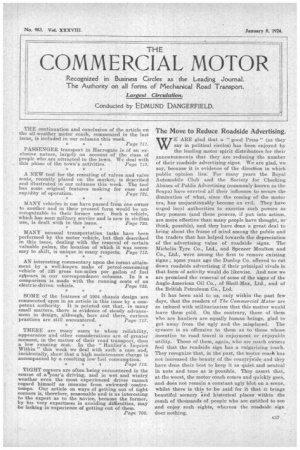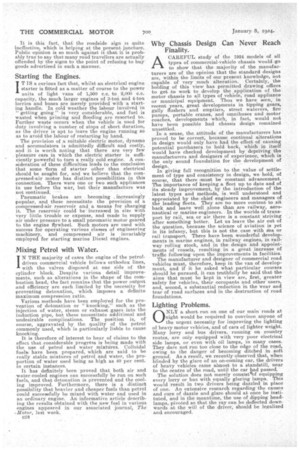The Move to Reduce Roadside Advertising.
Page 1

Page 2

If you've noticed an error in this article please click here to report it so we can fix it.
E ARE glad that a "good Press" (as they say in political circles) has been enjoyed by the leading motor spirit distributors for their• announcements that they are reducing the number of their roadside advertising signs. We are glad, we say, because it is evidence of the direction in which public opinion lies: For many years the Royal Automobile Club and the Society for Checking Abuses of Public Advertising (commonly known as the Scapa) have exerted all their influence to secure the diminution of what, since the coming of the motor era, has unquestionably become an evil. They have urged local authorities to exercise such powers as they possess (and those powers, if put into action, a-re more effective than many people have thought, or think, possible), and they have done a great deal to bring about the frame of mind among the public and the traders that has helped towards the depreciation of the advertising value of roadside signs. The Michelin Tyre Co., Ltd., and Spencer Moulton and Co., Ltd., were among the first to remove existing signs; some years ago the Dunlop Co. offered to cut down roadside advertising if their principal rivals in that form of activity would do likewise. And now we are promised the removal of some of the signs of the Anglo-American Oil Co., of Shell-Mex, Ltd., and of the British Petroleum Co., ad.
It has been said to us, only within the past few days, that the readers of The Commercial Motor are so imbued with utilitarianism that this matter would leave them cold. On the contrary, those of them Who are -hauliers are equally human beings, glad to get away from the ugly and the misplaced. The eyesore is as offensive to them at to those whose incentive to road travel is enjoyment or enjoyable utility. Those of them, again, who are coach owners feel that the roadside sign has a vulgarizing. touch. They recognize that, in the past, the Motor coack has not increased the beauty of the countiiside and they have done their best to keep it as quiet and neutral in note and tone ai is possible. They assertthat, at the worst, the motor coach comes and quickly goes, and does not remain a constant ugly blot on a scene, whilst there is this to be said for it that it brings beautiful scenery 'and historical places within the reach of thousands of people who are entitled to see and enjoy such sights, whereas the roadside sign does nothing. It is this fact, that the roadside sign is quite ineffeetive which is helping at the present juncture. Public opinion is so much against it that it is probably true to say that many road travellers are actually offended by the signs to the point of refusing to buy goods advertised in such a manner.
Starling the Engines.
IT IS a curious fact that, whilst an electrical engine starter is fitted as a matter of course to the power units of light vans of 1,500 c.c. to 2,000 c.c. capacity, the much larger engines of 3-ton and 4-ton lorries and buses are merely provided with a starting handle. In cold weather the labour involved in "getting going" is very considerable, and fuel is wasted when priming and flooding are resorted to. Further waste occurs when the vehicle is used for duty involving a number of stops of short duration, as the driver is apt to leave the. engine running so as to avoid the labour of restarting by hand. The provision of a suitable electric motor, dynamo and accumulators is admittedly difficult and costly, and it is worth noting that there are very few pleasure cars in which the electric starter is sufficiently powerful to turn a really cold engine. A consideration of these difficulties leads to the conclusion that some 'form of starter other than electrical should be sought for, and we believe that the compressed-air motor has distinct possibilities in this connection. There were one or two such appliances in use before the war, but their manufacture was not continue& ' • . Pneumatic brakes are becoming increasingly popular, and these necessitate the provision of a compressed-air reservoir and a means for charging it. The reservoir could be • increased in size with very little trouble or expense, and made to supply air under pressure to a small pneumatic motor geared to the engine flywheel. Such motors are used with success for operating various classes of engineering machinery, and compressed air is invariably employed for starting marine Diesel engines.
Mixing Petrol with Water.
IN THE majority of cases the engine of the petrol. drivencommercial vehicle follows orthodox lines, with the valves disposed at one side of the cylinder block. Despite various detail improvements, such as alterations in the shape of the combustion head, the fact remains that the power output and efficiency are each limited by the necessity for preventing detonation, which imposes a definite maximum compression ratio. Various methods have been employed for the prevention of detonation or "knocking," such as the injection of water, steam or exhaust gases into the induction pipe, but these necessitate additional and undesirable complications. The position is, of course, aggravated by the quality of the petro
i l commonly used, which s particularly liable to cause
knocking. It is therefore of interest to hear of claims to the effect that considerable progress is being made with the use of petrol and water mixtures. Colloidal fuels have been prepared, which are said to be really stable mixtures of petrol and water, the proportion of water used being as high as 40 per cent. in certain instances. It has definitely been proved that both air and water-cooled engines can successfully be run on such fuels, and that detonation is prevented and the cooling improved. Furthermore, there is a distinct possibility that heavier and cheaper fuels than petrol could successfully be mixed with water and used in an ordinary engine. An informative article describing the results obtained with the new fuel in various engines appeared in our associated journal, The .Motor, last week. . c.18
Why Chassis Design Can Never Reach Finality.
ACAREFUL study of the 1924 models of all types of commercial-vehicle chassis would .go to show that the majority of the manufacturers are of the opinion that the standard designs are, within the limits of our present knowledge, not capable of very much alteration. Certainly, the holding of this view has permitted drawing offices to get to work to develop the application of the motor chassis to all types of vehicle, road appliance or municipal equipment. Thus we have seen, in recent years, great developments in tipping gears, gully flushers and emptiers, street waterers, fire pumps, portable cranes, and omnibuses and motor coaches, developments which, in fact, would not have been possible had chassis design remained unsettled. In a sense, the attitude of the manufacturers has proved to be correct, because continual alterations in design would only have had the effect of causing potential purchasers to hold back, which in itself would have checked development by depriving the manufacturers and designers of experience, which is the only sound foundation for the development of design. In giving full recognition to the value of settlement of type and consistency in design, we hold, of course, that there must be constant advancement. The importance of keeping a fleet up to date and of its steady improvement, by the introduction of the latest types and methods, is .welIunderstood and appreciated by the chief engineers and managers of the leading fleets. They are no more content to sit back and leave well alone than are railway, aeronautical or marine engineers. In the worlds of transport by rail, sea or air there is a constant striving after something better. Let us leave the air out of the question, because the science of aviation is yet in its infancy, but this is not the case with sea or rail transport. There have been wonderful developments in marine engines,. in railway engines, in railway rolling stock, and in the design and appointments of vessels, resulting in a great increase of traffic following upon the improvements in facilities. The manufacturer and designer of commercial road vehicles must, therefore, keep in the van of development, and if it be asked what particular courses should be pursued, it can truthfully be said that the aims that must be kept in view are, first, greater safety for vehiclee, their occupants and other users, and, second, a substantial reduction in the wear and tear of road surfaces and in the destruction of road foundations.
Lighting Problems.
ONLY a short run on one of our main roads at night would be required to convince anyone of the urgent necessity for improving the lighting of heavy motor vehicles' and of cars of lighter weight. Many lorry and bus drivers, running on country routes, are only equipped with very poor electrical side lamps, or even with oil lamps, in many caaes. They dare not run too close to the edge of the road, owing to the .danger of becoming ditched in soft ground. As a result, we recently observed that, when blinded by the glare of an on-coming car, the drivers of heavy vehicles came almost to a standstill, near to the centre of the road, until the ear had passed. The solution does not merely consist%f equipping every lorry or bus with equally jeering lamps. This would result in two drivers being dazzled in place of one. An extensive research regarding the causes and cure of dazzle and glare should at once be instituted, and in the meantime, the use of clipping headamps, pivoted so that the ray can be deflected downwards at the will of the driver, should be legalized and encouraged.




























